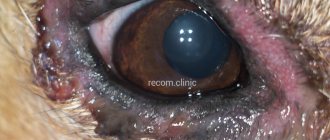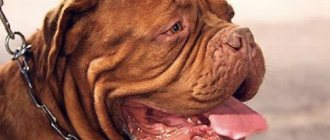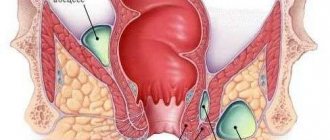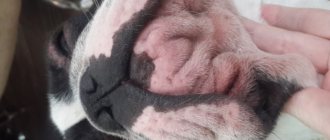Mammary tumors in dogs are quite common. About 50% of all diagnosed neoplasms are malignant neoplasms. The disease can develop not only in females, but also in males.
- Preparing the dog before removal
Pet owners should visit their veterinarian regularly for examination, consultation and, if necessary, treatment/surgery. Modern methods of treating mammary tumors in dogs have now been developed and are being successfully used, and effective methods of preventing the disease are also being used. There is only one condition - a timely visit to specialists in a reputable European clinic, which allows you to prevent the disease from progressing and improve the further prognosis if the pathology has already developed.
Attention!
If you discover a suspicious growth in your pet, you should immediately contact your veterinarian. You can’t waste time treating your dog with traditional methods, making compresses, etc. In addition, any changes in the mammary glands can be associated not only with oncological problems. Thus, a benign tumor of the mammary gland in a dog is often diagnosed (with a completely favorable prognosis).
Now specialized veterinary clinics have everything necessary for an accurate diagnosis. Experienced veterinarians will accurately determine the type of neoplasm and select an adequate treatment algorithm.
Causes of malignant tumors in dogs
The main risk group is the age of the animal, starting from six to seven years. According to statistics, after 10 years of life, various tumors of the mammary glands are diagnosed in every fifth pet.
Causes of the disease:
- Hormonal imbalances.
- Hereditary predisposition
- Genetic factor
Risk factors: 1. Sex hormones are a mechanism for triggering the development of many neoplasms. Hormonal imbalances for various reasons inevitably lead to the appearance of health problems in the animal, including tumors (benign and malignant). Failure to spay/castrate an animal leads to a significant increase in the likelihood of tumors. In neutered pets, the risk of cancer is virtually zero. Experts note that the operation (castration/sterilization) must be carried out within the time period recommended by veterinarians (usually when the animal is six months old). When sterilization/castration surgery is performed at a later date, the likelihood of developing benign tumors is significantly reduced, but such an operation has only a slight effect on the manifestation of cancer. Owners should not allow animals of reproductive age to go into empty heat. If breeding of offspring is not planned, surgery should be performed in a timely manner.
Can be diagnosed in all dog breeds.
2. The risk of tumors increases significantly if there are similar problems in the family.
Can be diagnosed in all dog breeds.
3. As veterinary practice shows, there are a number of breeds in which, compared to others, breast cancer pathologies are more often diagnosed.
The following animal breeds are at risk:
- English cocker spaniel
- Poodles
- German and Caucasian Shepherds
- Maltese dogs
- Yorkshire Terriers
- Setters.
Other risk factors include uncontrolled/long-term use of hormonal drugs, helminthic infestation, unbalanced diet, poor environment, various pathologies of the reproductive organs, a history of allergies, poisoning with poisons/chemicals, and metabolic disorders.
What does quantity affect?
Some novice dog breeders are unfoundedly afraid that the number of nipples may affect the success of feeding puppies. However, this is far from true: no matter how many tits dogs have, the main thing in this matter is the filling of the milk ducts with high-calorie milk. At the same time, the rear (inguinal) nipples produce more food, so it is recommended to place the weakest babies on them for faster weight gain.
You can judge how the mammary glands of a bitch cope with their functions by the condition and behavior of the offspring: well-fed puppies are shiny, thick-bellied, fall asleep easily after suckling and do not suffer from diarrhea. If the puppies are weak, squeak and do not gain weight, it means that the dog’s nipples are not working properly: little milk is produced, it is difficult for the babies to suck, and inflammation of the mammary gland has developed. In this case, the owner’s concern is to carefully examine the dog’s mother for the presence of traces of blood or pus in the milk. If the bitch is in good health, you can increase the productivity of the mammary glands with the help of special liquid dog food.
Types of mammary tumors in dogs
Main groups:
- Malignant tumor of the mammary gland in dogs.
- Neoplasm of benign nature.
Dozens of types of tumors are diagnosed, and only an experienced veterinarian, based on an external examination, symptoms and research, is able to draw a conclusion and indicate measures of medical care for the animal. The complexity of diagnosis is explained by histology, tumor localization, the presence or absence of damage to cell structures and tissues and is only accessible to a qualified specialist.
Malignant tumor
A characteristic symptom is the rapid development of the disease and the appearance of metastases. There are two forms of pathology:
- Nodular (small size of formations, single or multiple nature).
- Diffuse (with unclear boundaries, significant size with worse prognosis).
The following types of tumors can be diagnosed, namely:
- papillary adenocarcinoma;
- sarcomas;
- armored, tubular or anaplastic cancer;
- carcinomas.
Regarding the further prognosis, the greatest concern is the presence of adenocarcinoma and armored cancer.
Benign tumors
They have a sluggish course and no metastases.
Types:
- adenoma;
- fibroadenoma (the most common type, almost half of cases);
- papilloma;
- mixed form.
Such neoplasms are not life-threatening and respond well to treatment.
Features of lactation in dogs
1124 views
Nursing a litter is one of the most important periods in a dog’s life. It is associated with complex processes in the body, with high consumption of energy and nutrients. Therefore, it is so important to monitor the diet of a nursing bitch.
Immediately after giving birth, the dog secretes a thick and very nutritious substance - colostrum.
Its composition is maximally saturated with hormones, immunoglobulins, vitamins and minerals. Colostrum is essential for newborn puppies as it provides them with immune protection. It is easier to digest and is maximally absorbed by the puppy’s body. After a few days, the composition of colostrum gradually changes, turning into milk. This way the puppies smoothly transition to the new composition of their diet. Bitch milk, unlike cow's milk, has much more easily digestible protein, and it is more than twice as fat, and it also contains less lactose - milk sugar - the high content of which is a common cause of diarrhea in puppies. However, its quality and quantity differs depending on the individual characteristics of the dogs, health status, diet and living conditions. Milk is formed from substances in the bitch’s blood. This is a practically sterile liquid with a minimal amount of toxic impurities, which is obtained by filtering blood through the mammary glands. Therefore, a nursing bitch should receive only high-quality nutritious food. For the same reason, it is undesirable to take medications, treat the dog with antiparasitic drugs, and use cosmetics without consulting a veterinarian.
The number of nipples in a dog is from 8 to 12. They form two rows, often with an equal number in each. The number of nipples does not indicate the number of puppies born. Closer to the rear, the nipples are milkier, and weak or smaller puppies are usually placed on them. To determine whether puppies have enough milk, they need to be weighed and examined daily. Healthy and well-fed puppies are smooth, with shiny coat, elastic, without signs of diarrhea. Such puppies quickly gain weight, and, having eaten, they sleep huddled together.
Weak, thin puppies that do not gain weight well and squeak for a long time are a sign that the dog either has little milk or has tight nipples, and may be developing inflammation of the mammary gland - mastitis. The owner must check the milk for color and consistency, whether there are any impurities of blood or pus in it - signs of inflammation. In this case, the dog needs to be shown to a veterinarian immediately.
If the dog is healthy, but has little milk, you can give it liquid food, more liquid, carefully monitoring the change in the amount of milk. During the period of feeding puppies, hygiene of the mammary glands is also important. After a walk, you need to wash them with warm water and soap and wipe them dry with a soft towel. If the dog has long hair, then dry the fur on the belly with a warm hairdryer, since in a damp environment diaper rash forms and a fungal infection develops.
Typically, the lactation period lasts from 6 to 8 weeks. The older the puppies become, the more often the dog may leave them, going to sleep in its place and returning to the nest only to feed them. There is no need to force the dog into the nest; give it the opportunity to rest and gain strength.
dog giving birth
Share
Symptoms of the disease
Since the mammary glands are located in plain sight, warning signs are not difficult to spot.
You should pay attention to the presence of:
- compactions and redness;
- softness, friability or, on the contrary, density of formations;
- changes in the shape and color of the nipples, as well as discharge from them;
- hyperemia in the affected area;
- anxiety of the animal during the examination (due to pain and discomfort).
If the condition is advanced, the formations open and a fistula appears. The animal refuses to eat, walk and play.
Caring for a pregnant bitch
Caring for a pregnant female Chihuahua is not as difficult as it may seem. The main rule that the owner should remember is more affection and no unnecessary stress. Excessive loads and overvoltage should not be allowed.
Walking in the fresh air is necessary, but you need to make sure that the animal is not too tired or stressed.
What to pay attention to before giving birth
The prenatal condition has a lot of noticeable signs. The dog’s behavior becomes more restless, it begins to build a kind of “nest” where it will give birth. Body temperature drops and the animal may begin to tremble. The pet may also begin to refuse food.
All of these signs indicate that the due date has almost arrived, and the owner needs to prepare for the arrival of the babies.
Chemotherapy use
The question of its appointment is the prerogative of the doctor. A method that has a whole list of serious side effects (impaired liver, kidney, cardiovascular system, etc.) is used as an additional method in two cases:
- after operation;
- as a treatment if surgery is not possible for any reason.
A course of chemotherapy cannot guarantee complete recovery in the presence of certain types of cancer and stages 3-4 of the disease.
Preparing your dog before removing a mammary tumor
Includes laboratory blood tests to identify possible concomitant pathologies. The pet owner is given individual recommendations and the mastectomy is scheduled on a convenient day.
How long do dogs with mammary tumors live?
Life expectancy depends on many factors (stage/type of tumors). Usually, in stages 1 and 2, the animal recovers after treatment; in stage 3, metastases are detected after about six months.
Treatment and removal of a dangerous tumor
Having confirmed the diagnosis, the doctor develops a treatment regimen. The form of cancer, stage, condition of the lymph nodes, as well as the individual characteristics of the body are taken into account. The predominant method of treatment remains surgical removal of the tumor with complete excision of the mammary ridge and adjacent lymph nodes.
Surgery works more effectively for nodular cancer.
After the operation, the pet will undergo a course of chemotherapy to consolidate the results and prevent relapses.
Chemotherapy is also prescribed in inoperable cases. For example, with a diffuse form, which does not allow complete removal of the affected areas.
I strongly do not recommend self-medication! You risk making a mistake in diagnosis.
In addition, antitumor drugs that are available in veterinary pharmacies, if used incorrectly instead of treatment, can have the opposite effect and provoke accelerated tumor growth and exacerbation of the disease.
Prevention
The main and most effective preventive measures include timely castration of the animal, regular visits to the veterinarian (at least once every 6 months), implementation of all recommendations of care specialists (elimination of stress and illiterate hormone therapy, provision of high-quality nutrition, timely treatment of any diseases of the body, including mammary glands/reproductive system).
Mammary tumors in dogs are becoming a serious problem for pet owners. An operation performed in a timely manner by a qualified surgeon in a specialized veterinary clinic is the only correct decision in the presence of this diagnosis. Surgery requires practical experience and high qualifications of the doctor. Only a specialist who is fluent in modern techniques will be able to provide adequate treatment. In order to save the life of your pet, contact only professionals!
Symptoms of metastasis
Symptoms of metastases directly depend on the location of the primary tumor and the number of metastases. Common symptoms for all types of metastases are:
- lethargy;
- refusal of food;
- weight loss;
- apathetic state.
Symptoms of metastases in the lungs in a dog are a prolonged cough that does not respond to antibiotic therapy, shortness of breath, and sometimes lameness.
Symptoms of metastases in the liver are often spawning of the mucous membranes, constipation, diarrhea, vomiting, and refusal to feed. The liver is quite often a target organ for metastases.
Lesions of the endocrine system organs are characterized by a voluminous neoplasm in the neck (with a tumor of the thyroid gland), cough, weight loss, vomiting, convulsions, shock, and possible paresis of the pelvic limbs.
Autopsy of external tumors (skin tumors, melanomas, mastocytes) is characterized by the presence of an open wound. More often than not, it doesn’t even bleed (due to trophic disturbances). The presence of metastases to other organs in this situation is almost 100%.











